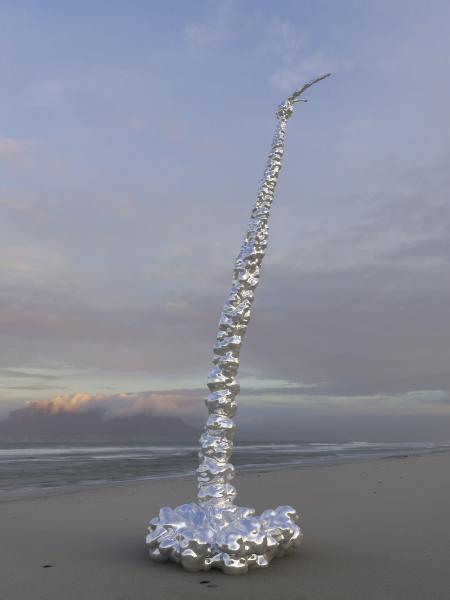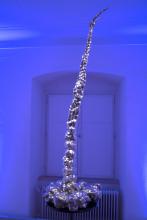Sculptures derived from archival photos of the space shuttle Challenger explosion in 1986, which killed all seven crew members and set back the manned exploration of space for decades.
T= 0 - +73.191 is based on archival photos of the disaster, is cast from aluminum and polished to reflect the surrounding environment.
The sculpture functions as a physical timeline from ignition to the explosion.
| T=00.000 | Solid rocket ignition command is sent. | T+72.564 | Data shows a sudden lateral acceleration to the right jolts the shuttle with a force that may have been felt by the crew. |
| T+01.000 | Astronaut Judy Resnik, intercom: “Aaall Riight!” Shuttle pilot Michael Smith, intercom: “Here we go.” |
T+72.624 | Solid rocket boosters continue showing high nozzle motion rates. |
| T+64.705 | A leak has started in the shuttle’s liquid hydrogen tank. |
T+72.964 | Challenger beams back its final navigation update. |
| T+64.937 | A bright, sustained glow is photographed on the side of the external fuel tank. |
T+73.000 | Main engine liquid oxygen propellant pressures begin falling sharply at turbopump inlets. |
| T+65.524 | Evidence of Challenger experiencing transient motion. |
T+73.010 | Smith, intercom: “Uh oh...” This is the last comment captured by the crew cabin intercom recorder. |
| T+66.000 | Data shows the left wing’s outboard elevon moves suddenly. |
T+73.044 | Last data is captured by the Tracking and Data Relay Satellite in orbit overhead, indicating structural breakup has begun in that area. |
| T+66.174 | Booster systems engineer: “Throttle up, three at 104.” Greene: “Capcom (Covey), go at throttle up.” |
T+73.045 | Sharp decrease in liquid hydrogen pressure to the main engines. |
| T+66.764 | Tracking cameras show a bright spot suddenly appears in the exhaust plume from the side of the right-side rocket motor. |
T+73.137 | Internal pressure in the right-side rocket booster is recorded,indicating about 100,000 pounds less thrust. Tracking cameras detect evidence indicating a massive rupture near the SRB-tank attach ring. Forward acceleration begins pushing the tank up into the liquid oxygen section in the tip of the external fuel tank. |
| T+67.684 | The flame has wrapped around the joint as the leak deteriorated. |
||
| T+68.000 | Telemetry indicates falling pressure in the 17-inch-wide liquid oxygen propellant lines feeding the three main engines. |
T+73.143 | Vapors appear near the intertank section separating the hydrogen and oxygen sections accompanied by liquid hydrogen spillage from the aft dome of the external tank. |
| T+70.000 | Nesbitt: “Engines are throttling up. Three engines now at 104 percent.” Covey: “Challenger, go at throttle up.” |
||
| T+72.204 | Scobee, air-to-ground: “Roger, go at throttle up.” | T+73.162 | All three main engines respond to loss of oxygen and hydrogen inlet pressure. A sudden cloud of rocket fuel appears along the side of the external tank. The nose of the right-hand booster pivoted into the intertank area, compounding the liquid oxygen rupture. |
| T+72.284 | Data shows divergent up and down motions of the nozzles at the base of both solid rocket boosters. |
||
| T+72.478 | A large ball of orange fire appears higher on the other side of main fuel tank, closer to Challenger’s cabin, and grows rapidly. |
T+73.191 | A sudden brilliant flash is photographed between the shuttle and the external tank. Fireballs merge into bright yellow and red mass of flame that engulfs Challenger. A single crackling noise is heard on air-to-ground radio |
| T+72.525 | The nozzles of the three liquid-fueled main engines begin moving at high rates: Five degrees per second. |



